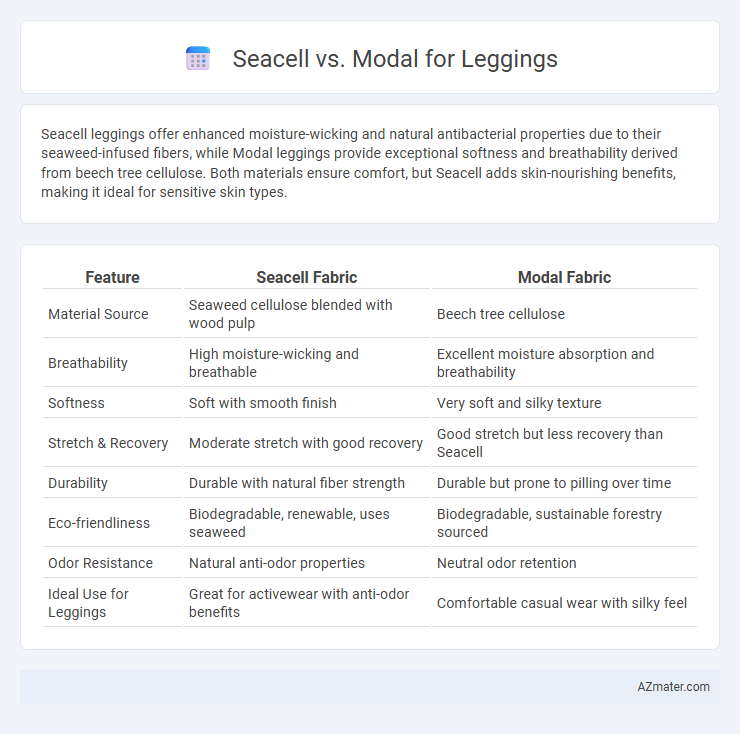Seacell leggings offer enhanced moisture-wicking and natural antibacterial properties due to their seaweed-infused fibers, while Modal leggings provide exceptional softness and breathability derived from beech tree cellulose. Both materials ensure comfort, but Seacell adds skin-nourishing benefits, making it ideal for sensitive skin types.
Table of Comparison
| Feature | Seacell Fabric | Modal Fabric |
|---|---|---|
| Material Source | Seaweed cellulose blended with wood pulp | Beech tree cellulose |
| Breathability | High moisture-wicking and breathable | Excellent moisture absorption and breathability |
| Softness | Soft with smooth finish | Very soft and silky texture |
| Stretch & Recovery | Moderate stretch with good recovery | Good stretch but less recovery than Seacell |
| Durability | Durable with natural fiber strength | Durable but prone to pilling over time |
| Eco-friendliness | Biodegradable, renewable, uses seaweed | Biodegradable, sustainable forestry sourced |
| Odor Resistance | Natural anti-odor properties | Neutral odor retention |
| Ideal Use for Leggings | Great for activewear with anti-odor benefits | Comfortable casual wear with silky feel |
Introduction to Seacell and Modal Fabrics
Seacell fabric is a sustainable textile made by blending cellulose fibers with seaweed extract, known for its skin-soothing properties and eco-friendly production. Modal, a type of rayon derived from beech tree pulp, offers exceptional softness, breathability, and moisture-wicking capabilities for comfortable legging wear. Both fabrics excel in providing stretchability, durability, and smooth texture, making them popular choices for activewear and everyday leggings.
What Makes Seacell Unique for Leggings
Seacell leggings stand out due to their incorporation of seaweed fibers, which infuse the fabric with natural minerals and antioxidants, promoting skin hydration and soothing properties during wear. Unlike Modal, which emphasizes softness and breathability from beechwood pulp, Seacell's eco-friendly blend enhances moisture management while providing anti-inflammatory benefits. The unique bioactive compounds in Seacell fabric set these leggings apart by combining performance with skincare advantages.
Key Properties of Modal in Activewear
Modal fabric, derived from beech tree pulp, offers exceptional breathability and moisture-wicking properties, making it ideal for activewear leggings. Its silky smooth texture enhances comfort and reduces chafing during physical activity, while superior elasticity ensures a flexible fit that supports movement. Durable and resistant to shrinkage, Modal maintains shape and softness through multiple washes, providing long-lasting performance for workout wear.
Comfort Comparison: Seacell vs Modal
Seacell leggings offer superior moisture-wicking and antibacterial properties, enhancing overall comfort by keeping the skin dry and fresh throughout the day. Modal leggings provide exceptional softness and breathability, ensuring a smooth, lightweight feel that reduces irritation during extended wear. When comparing comfort, Seacell excels in temperature regulation and odor control, while Modal stands out for its silky texture and natural stretch.
Sustainability and Environmental Impact
Seacell leggings, made from seaweed-infused fibers, offer biodegradability and natural skin benefits, reducing chemical use and supporting marine ecosystem health. Modal leggings, derived from sustainably sourced beech wood pulp, provide a lower carbon footprint and require less water than traditional cotton, enhancing environmental sustainability. Both fabrics promote eco-conscious fashion, but Seacell's marine-based origin uniquely supports ocean conservation while Modal excels in resource efficiency.
Moisture-Wicking Abilities of Both Fabrics
Seacell fibers, infused with seaweed nutrients, offer excellent moisture-wicking properties by efficiently drawing sweat away from the skin, promoting faster evaporation and enhanced comfort during workouts. Modal, made from beech tree pulp, boasts high moisture absorbency and breathability, but its wicking ability is slightly less effective compared to Seacell, making it ideal for moderate activity levels. Both fabrics provide soft, breathable comfort, yet Seacell leads in moisture management for high-intensity legging performance.
Durability and Longevity in Leggings
Seacell leggings offer superior durability due to their blend of cellulose fibers combined with seaweed extracts, providing enhanced fiber strength and resistance to wear. Modal leggings, made from beech tree cellulose, are known for softness and breathability but tend to have a slightly lower abrasion resistance compared to Seacell fabrics. Over time, Seacell leggings maintain their shape and texture better, making them a longer-lasting option for frequent wear and washing.
Skin Benefits: Seacell versus Modal
Seacell leggings offer superior skin benefits due to their infusion of seaweed fibers rich in vitamins and antioxidants, promoting hydration and reducing inflammation. Modal leggings provide excellent breathability and softness, enhancing comfort but lacking the bioactive compounds found in Seacell. Choosing Seacell fabric supports improved skin health by continuously releasing nutrients, while Modal prioritizes moisture-wicking and smooth texture for daily wear.
Care and Maintenance for Each Fabric
Seacell leggings require gentle washing with cold water and mild detergent to preserve their seaweed-infused fibers, avoiding bleach and fabric softeners to maintain fabric integrity. Modal leggings benefit from machine washing on a cool, gentle cycle and can be tumble dried on low, but air drying is recommended to extend the fabric's softness and prevent shrinkage. Regular care for both fabrics ensures their durability and comfort, with Seacell demanding more delicate handling due to its eco-friendly cellulose fibers.
Which Fabric is Better for Leggings?
Seacell fabric offers natural breathability and moisture-wicking properties ideal for activewear leggings, enhancing comfort during workouts and everyday wear. Modal, known for its softness and excellent stretch retention, provides a smooth, luxurious feel that resists pilling and maintains shape over time. For leggings, Seacell is better suited for moisture management and eco-friendly appeal, while Modal excels in softness and durability, making the choice dependent on the desired performance and comfort priorities.

Infographic: Seacell vs Modal for Legging
 azmater.com
azmater.com